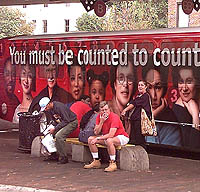|
Para ver este documento en
español, oprima aquí.
THE ORLANDO SENTINEL
Hispanics Encouraged To Make 2000 Census Count
by Denise-Marie Balona
November 28, 1999
Copyright © 1999 THE ORLANDO SENTINEL. All Rights Reserved.
 Numbers
add up. The Census Bureau is getting the message out
on a Lynx bus, in newspapers, on radio and TV, and even door-to-door.
Reaching Hispanic households is a priority. (PHOTO:
RED HUBER/THE ORLANDO SENTINEL) Numbers
add up. The Census Bureau is getting the message out
on a Lynx bus, in newspapers, on radio and TV, and even door-to-door.
Reaching Hispanic households is a priority. (PHOTO:
RED HUBER/THE ORLANDO SENTINEL)
This is your future. Don't leave it blank.
That is the message written in English and Spanish on a shiny
red Lynx bus.
Soon, officials trying to get the word out about the 2000 Census
will have it spread over Central Florida in bilingual newsletters
and advertisements and on T-shirts and buttons.
Every 10 years, the U.S. Census Bureau conducts a complete
account of everyone, no matter where they live or what language
they speak. The next survey will be mailed to every household
in March and ask questions about things such as gender and race
and whether a home is owned.
Reaching Hispanics, who in 1990 were Florida's most undercounted
group, is a priority for Central Florida communities. Many have
committees.
"We want to let them know they are part of the census
even though they often come from different countries," said
Marytza Sanz Guzman, the liaison between the Census Bureau and
Hispanics in Central Florida. "The biggest step that we have
to do in our community is teach why."
Census records help governments decide how to spend $162 billion
annually for projects such as roads, schools, housing assistance
and medical programs. Some of those funds, if the government sees
a need, could go to increase bilingual education and other services
targeting Hispanics.
"If they know we are here and we are growing, they will
send more money," Osceola County community leader Domingo
Toro said. "Everybody thinks this is intrusive, but that's
when education comes in. Census will give us a sense of direction."
A challenge will be reaching migrants and convincing Hispanics
who might be here illegally. Some worry the information will be
used against them, but that fear is unfounded, said Betsy Franceschini,
former president of the Puerto Rican Association of Central Florida
and the head of a subcommittee promoting the census locally.
People should not worry about being deported or getting into
trouble, she said, because the data by law cannot be shared with
other agencies such as the Immigration and Naturalization Service.
"There is a lot of fear, but it is confidential information,"
she said. "We really need to educate the immigrants because
they are the ones who will be most afraid to fill out the forms."
An undercount hurts everybody.
Florida's net undercount in 1990 was estimated at 260,000,
with 34 percent being Hispanic. Orlando alone lost $4 million
in federal funding because of the undercount, census officials
said.
Information on race and Hispanic origin is used to implement
programs for equal employment and civil rights. Businesses rely
on information to create jobs and make products residents want.
Local governments want everyone to know the importance of participation.
Groups in Seminole and Volusia counties have sent out bilingual
newsletters and plan to open booths at special events. Osceola
officials want electric bill inserts and Web sites dedicated to
the project.
Orange County plans an all-out effort for several months with
promotions on Spanish-language television and radio stations and
in newspapers. Volunteers will knock on doors and blast messages
over speakers. Teachers will bring information to class so children
can take it home. Hispanic musicians and church leaders will help.
"People can say, 'I can recognize that voice that is trustable,'
" Sanz Guzman said. "We all know when a message comes
from the church, it's serious."
Jerry Jackson of the Sentinel staff contributed to this
report.
| 
